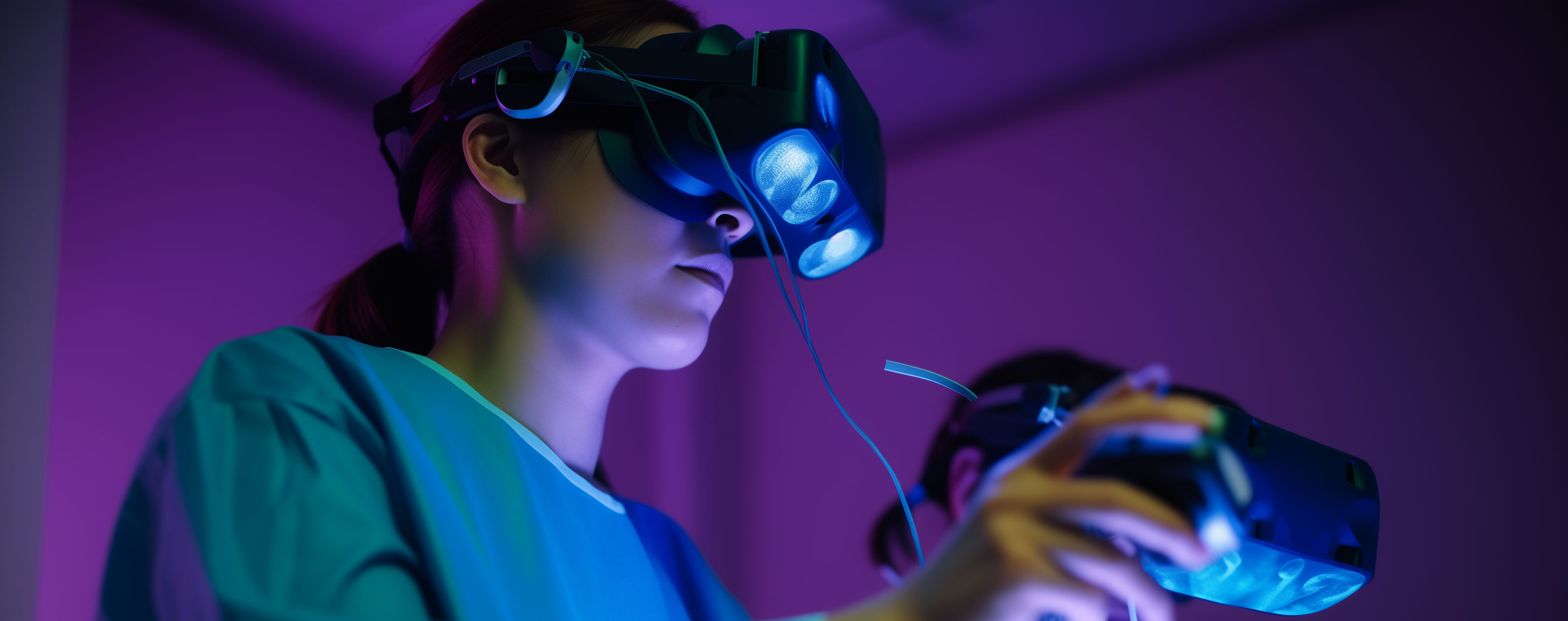
Immersive Learning: The Impact of VR and AR on Healthcare Training
The convergence of Virtual Reality (VR) and Augmented Reality (AR) technologies has ushered in a transformative era for healthcare training, revolutionizing the way medical professionals acquire and enhance their skills. In this article, we delve into the profound impact of VR and AR on medical education.
Understanding the Essence: VR vs. AR
Before we explore their applications in healthcare training, let's clarify the fundamental differences between Virtual Reality (VR) and Augmented Reality (AR).
Virtual Reality (VR): VR immerses users in a completely digital environment, shutting out the physical world. It creates a simulated reality that users can interact with, often using specialized headsets. In healthcare training, VR provides immersive simulations for medical education, surgical planning, pain management, and physical rehabilitation [1][5].
Augmented Reality (AR): AR overlays digital information onto the real world, enhancing the user's perception of reality. Unlike VR, AR does not replace the real world but supplements it with additional digital elements. In healthcare, AR complements medical education by providing interactive and informative experiences, overlaying digital information onto the physical environment [2][4][5].
Virtual Reality's Revolution in Healthcare Training
Virtual Reality (VR) has emerged as a revolutionary tool in healthcare training, offering immersive experiences that transcend traditional learning methods [1]. Key areas of impact include medical education, surgical planning, pain management, and physical rehabilitation.
Medical Education in Virtual Environments
VR has breathed new life into medical education, allowing students to engage in realistic simulations of complex surgical procedures and rare medical conditions [1][3]. These immersive environments provide hands-on experience in a virtual yet incredibly lifelike setting, enabling medical professionals to refine their skills without putting real patients at risk [1].
Moreover, the integration of VR in medical education extends beyond simulations. It encompasses interactive 3D models of anatomical structures, providing students with a comprehensive understanding of human anatomy and function [3]. The ability to manipulate digital subjects enhances spatial awareness and facilitates in-depth exploration, overcoming the limitations of traditional teaching tools like cadavers and textbooks [3].
Advancements in Surgical Planning
Surgeons are leveraging VR to enhance surgical planning and practice. By creating detailed 3D models of a patient's anatomy, surgeons can simulate and refine surgical procedures in a virtual environment [5]. Companies like Osso VR offer immersive surgical training modules, enabling surgeons to familiarize themselves with new procedures and medical devices [5]. This not only improves the precision of surgeries but also reduces operating time and complications [5].
Pain Management and Therapy
In the realm of pain management, VR has proven to be a valuable asset. Patients undergoing painful procedures can immerse themselves in soothing VR environments, diverting their attention from the pain [5]. Additionally, VR therapy, employing cognitive behavioral techniques, aids patients in relaxation and pain management, with FDA-approved solutions demonstrating remarkable success [5].
Transforming Physical Rehabilitation
The impact of VR extends to physical rehabilitation, where companies like MindMaze utilize VR to create personalized exercises within virtual environments [5]. Patients recovering from injuries or surgeries can engage in interactive exercises, enhancing engagement and allowing therapists to monitor progress more effectively [5].
Augmented Reality's Role in Enhancing Medical Training
While VR provides immersive simulated experiences, Augmented Reality (AR) overlays digital information onto the real world, offering a unique perspective in healthcare training. Let's explore how AR complements medical education, providing valuable insights and enhancing practical skills [2][4][5].
AR in Medical Education: Enhancing Student Experiences
Augmented Reality is increasingly recognized for its ability to enhance medical education by providing students with interactive and informative experiences [2]. AR-based programs offer a vast potential to prepare medical professionals for real-world practice, providing a safe educational environment and addressing specific professional skills [4].
AR's Impact on Practical Skills in Medical Training
AR contributes significantly to the development of practical skills in medical training, addressing the expectations of comprehensive medical graduates [2]. In surgical procedures, AR can overlay patient-specific anatomical information obtained from imaging scans, offering surgeons valuable insights and improving the precision of the procedures [4]. This is particularly evident in specialties like kidney surgery and extracorporeal membrane oxygenation cannulation [4][5].
AR in Remote Consultations and Diagnostics
The growth of telemedicine, accelerated by the COVID-19 pandemic, has seen an increased reliance on AR and VR technologies [5]. AR technologies enhance remote consultations by providing real-time access to patient data and vital signs, offering a more immersive and informative experience for both patients and healthcare providers [5].
Challenges and Opportunities in Implementing VR and AR in Healthcare Training
While the benefits of VR and AR in healthcare training are evident, there are challenges that healthcare institutions must navigate for seamless integration [5]. These challenges include integration and adoption complexities, cost barriers, and the delicate balance between innovation and regulatory compliance [5].
Opportunities for the FutureDespite the challenges, the integration of VR and AR in healthcare presents significant opportunities for the future. These technologies can enhance patient care, bridge healthcare accessibility gaps, and open new frontiers for medical research [5].
Conclusion: Shaping the Future of Healthcare Training
In conclusion, the synergy of Virtual and Augmented Reality in healthcare training is reshaping the landscape of medical education. VR's immersive simulations and AR's overlay of digital information provide a holistic approach to training medical professionals, offering hands-on experiences and enhancing practical skills. As these technologies continue to evolve, healthcare training stands on the cusp of a transformative era, where innovation and patient-centric care converge.
Notes and References
- How VR is Revolutionising Training in Healthcare - Future Visual. https://www.futurevisual.com/blog/vr-training-healthcare/
- Horowitz, Brian T. (2022, December 15). How AR & VR in Healthcare Enhances Medical Training - HealthTech. https://healthtechmagazine.net/article/2022/12/ar-vr-medical-training-2023-perfcon
- Pottle, Jack. (2019, October). Virtual Reality and The Transformation of Medical Education - National Library of Medicine. https://www.ncbi.nlm.nih.gov/pmc/articles/PMC6798020/
- Dhar Poshmaal, Rocks Tetyana, et al. (2019, October). Augmented Reality in Medical Education: Students’ Experiences and Learning Outcomes - National Library of Medicine. https://www.ncbi.nlm.nih.gov/pmc/articles/PMC8281102/
- Suk, Julia. (2021, July 14). The Transformative Impact of AR-VR in Healthcare - Hurix. https://www.hurix.com/the-transformative-impact-of-ar-vr-in-healthcare/
